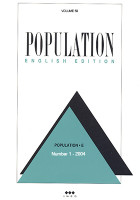
Population 2004 n° 1
2004
- The Returns to Education and Experience: Trends in France over the Last Thirty-Five Years - Selz Marion, Thélot Claude
- An Estimation of the Foreign-Origin Populations of France in 1999 - Tribalat Michèle
- The Demography of a Learned Society: the Académie des Sciences (Institut de France), 1666-2030 - Leridon Henri
Short papers
- Detecting Stopping and Spacing Behaviour in Historical Demography. A Critical Review of Methods - J. VAN BAVEL
- A Comparison Between Homeless, Domiciled and Vulnerable Populations in Madrid - M. MUÑOZ, C. VÁZQUEZ, J. J. VÁZQUEZ
- Determinants of Electoral Non-Registration and Sensitive Neighbourhoods in France - J.-L. PAN KÉ SHON
The returns to education and experience: trends in France over the last thirty-five years
Selz Marion, Thélot Claude
A single model applied to data from a large number of surveys covering thirty-five years provides highly empirical but comparable measurements of the economic returns to education and to experience, in the most general sense of that term, and of their evolution in France. While this model does not form the "true" model of these returns, it supplies an interpretative framework of relatively clear synthetic rates. The relative fragility of the approach in respect of conceptual choices (which concepts of education and experience?) and empirical choices (what level of data precision, which estimates?) raises doubts about the potential contribution of excessive sophistication in models and econometric methods. The results point up the explanatory power of the model and indicate that the returns to education exceed those to experience. The income returns to education fell gradually between 1962 and 1985, since when they have remained stable. This overall trend in fact masks a rise in the returns to very short periods of schooling, a clear decline at around thirteen years of schooling (corresponding to the baccalauréat), and virtual stability for the longest periods.
An estimation of the foreign-origin populations of France in 1999
Tribalat Michèle
The long tradition of immigration to France notwithstanding, the composition of the country’s foreign-origin population did not become known in any detail until the end of the twentieth century. Three attempts to produce an overall estimate of the foreign-origin population were made in the last century (1927, 1942 and 1986) but none could distribute it by precise origin. This is now possible thanks to the new questions included in the 1999 EHF survey (parental country of origin and language use), even though the method of estimation is extremely complex and includes some uncertainties related notably to the difficulty of separating the descendants of immigrants from those of repatriates born in the former colonies. The historical depth supplied by the EHF survey provides a degree of distancing from topical concerns and highlights the large demographic contribution of the migration streams that tend to be forgotten because they are older (or have comprised several waves). Of nearly 14 million persons of foreign origin (immigrants or persons with at least one immigrant parent or grandparent), 5.2 million are of southern European origin, while only 3 million are of Maghrebin origin.
The demography of a learned society: the Académie des Sciences (Institut de France), 1666-2030
Leridon Henri
Most academies are closed societies: members are admitted by election and remain until their death, and the total population usually remains constant over a given period. The demography of a closed body of this kind is simple: the annual intake is strictly determined by the annual "exits", i.e. deaths, which is an exogenous variable. As a result, the rate of intake and the length of service in the institution are fully related, and also depend on age at election. In a context where the length of life is increasing (via the fall in mortality at ages above 60), the mean age of the population can only rise - unless the Academy elects ever younger members, which, in turn, reduces the rate of renewal. A more efficient solution is to set an age at which a seat is declared vacant.
This article begins with a summary of the main mechanisms at work in a stationary population. We then provide a brief overview of the history of the Académie des Sciences between 1666 and 2001 and a reconstruction of the evolution of its population (1,039 members over this period). After some comparisons with other academies, we conclude with the results of 30-year projections based on different hypotheses for changes in entry and exit rules - in particular the changes resulting from the amendments to the statutes adopted in 2002.
Prix TTC : 20,00 €

